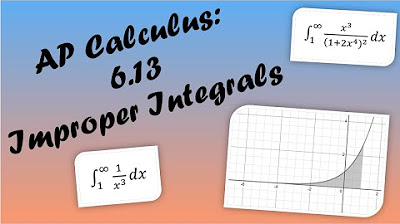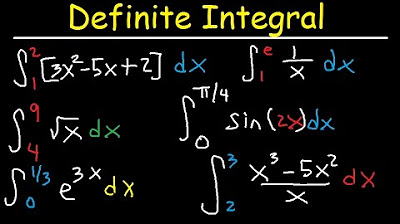How to solve type 1 improper integrals! calculus 2
TLDRThis video tutorial delves into the concept of improper integrals, specifically focusing on type one integrals which involve infinite intervals. The presenter explains the process of dealing with such integrals by integrating and then evaluating the limit. Eight examples are covered, showcasing various techniques such as u-substitution, integration by parts, and the use of L'Hopital's rule. The video emphasizes the importance of recognizing when an integral converges and when it diverges, providing clear calculations and conclusions for each example.
Takeaways
- 📚 Improper integrals are categorized into two types, with type one involving integration over an infinite interval.
- 🌟 The strategy for dealing with improper integrals involves separating the integration and the limit into two distinct components.
- 🔄 For the first example, the integral of 1/(x+1)^(3/2) from 0 to infinity converges, using u-substitution with u=x+1.
- 📈 The convergence of an integral can often be determined by examining the p-integral where p must be greater than 1.
- 🔢 For the second example, the integral of x^2/(√(x^3+4)) from 0 to infinity does not converge, as the p-integral test fails with p less than 1.
- 🚦 When dealing with improper integrals, the limit as the upper bound approaches infinity is a critical concept.
- 🌐 For the third example, the integral of e^(1/x)/x^2 from 1 to infinity converges and can be solved using u-substitution and the integral of e^u.
- 📊 The fourth example involves integration by parts for the integral of ln(x)/x^2 from 1 to infinity, which results in a convergent integral.
- 🔑 The use of integration by parts is highlighted for integrals that do not lend themselves to u-substitution, such as the fourth example.
- 🌀 The concept of switching the order of integration when dealing with a negative integral is introduced, which can simplify the process.
- 📝 The script provides a step-by-step approach to solving each improper integral, emphasizing the importance of understanding the process for each type.
- 🎓 The video script serves as an educational resource for learning how to handle and compute improper integrals, with eight examples provided for type one integrals.
Q & A
What is the definition of a Type 1 improper integral?
-A Type 1 improper integral is an integral where the interval of integration is infinite, specifically from a point to infinity.
How is the integral of 1/(x^(3/2)) from 0 to infinity approached?
-The integral is approached by using u-substitution with u equal to x+1. After differentiating and integrating, the result is a convergent integral, and the final answer is 2.
What substitution method is used for the integral of x^2/(sqrt(x^3) + 4) from 0 to infinity?
-The substitution method used is u = x^3 + 4, with du = 3x^2 dx, which simplifies the integral and shows that it diverges to infinity.
How does the video demonstrate the integral of e^(1/x)/x^2 from 1 to infinity?
-The video uses u-substitution with u = 1/x and du = -1/x^2 dx. After integrating and applying the limits, the result is e - 1, indicating a convergent integral.
What is the main strategy for dealing with improper integrals?
-The main strategy is to transform the improper integral into a limit problem by changing the infinite interval to a finite one and then evaluating the limit.
How does the video handle the integral of ln(x)/x^2 from 1 to infinity?
-The video uses integration by parts, with the integral represented as an integral of (1/x) * (-1/x), which simplifies to -ln(x)/x. After applying the limits, the result is 1, showing that the integral converges.
What is the result of the integral of x/(1 + x) from 0 to infinity?
-The integral is evaluated using partial fraction decomposition, and the result is pi/4, showing that the integral converges.
What is the issue with the integral of cos(x) from 0 to infinity?
-The integral diverges because the sine function, which is the antiderivative of cos(x), does not approach a finite value as x approaches infinity.
How does the video address the integral of x*e^x from negative infinity to 0?
-The video uses integration by parts and concludes that the integral evaluates to -1, taking into account the limit behavior of e^(-infinity) as 0.
What is the final result of the integral of (1/x^2 - x) from 2 to infinity?
-After applying partial fraction decomposition and evaluating the integral, the final result is ln(2), as the logarithm of the ratio (infinity to 2) converges to this value.
Outlines
📚 Introduction to Type 1 Improper Integrals
The paragraph begins with an introduction to Type 1 improper integrals, which are integrals over an infinite interval. The speaker explains that the key to handling these integrals is to remember two things: integration and limits. The first example provided is an integral from zero to infinity of 1/x^(3/2) + 1, which is demonstrated using u-substitution. The speaker emphasizes that recognizing whether the integral converges or diverges is crucial, and the example provided converges due to the p-integral test with p > 1. The computation of the integral's value is skipped with an emphasis on the conclusion that the limit approach is essential in these types of problems.
🧠 Understanding Convergence and Divergence in Improper Integrals
This paragraph delves into the concept of convergence and divergence in improper integrals, using the example of an integral from zero to infinity of x^2/(x^3 + 4). The speaker uses u-substitution again and explains the process of differentiating and integrating in the 'u world'. The integral is shown to diverge as the term u^(-1/2) does not converge to a finite value, but instead approaches infinity. The computation of the divergent integral is discussed, highlighting the difference between a convergent and divergent result.
🌟 Techniques for Solving Improper Integrals
The speaker introduces various techniques for solving improper integrals, such as u-substitution and integration by parts. The examples include integrals involving exponential functions and logarithmic functions. The paragraph emphasizes the importance of correctly applying these techniques and understanding their implications on the convergence or divergence of the integral. The speaker also discusses the use of properties of functions, such as the limit behavior of e^x and ln x, to simplify the evaluation of the integrals.
📈 Integration by Parts and Its Applications
This section focuses on the application of integration by parts for solving improper integrals. The speaker presents an integral from one to infinity of ln(x)/x^2 and explains the process of differentiating and integrating by parts. The explanation includes the computation of the integral's value, highlighting the importance of correctly applying the integration by parts formula. The conclusion is that the integral converges to a finite value, and the speaker provides a clear step-by-step method for solving similar problems.
🤔 Analyzing Trigonometric Functions in Improper Integrals
The speaker discusses the integration of trigonometric functions in the context of improper integrals. The example given is an integral from zero to infinity of cos(x) dx. The integral is solved using standard integration techniques, and the speaker points out the issues with taking the limit as x approaches infinity. The conclusion is that the integral diverges, and the speaker advises on the correct terminology to use when describing the result of such integrals.
🧩 Factoring and Partial Fractions for Improper Integrals
The paragraph covers the method of factoring and using partial fractions to solve improper integrals. The example is an integral from two to infinity of 1/(x^2 - x). The speaker demonstrates how to factor the denominator and set up the partial fractions correctly. The integral is then solved by integrating each term separately and combining the results. The speaker emphasizes the importance of combining logarithmic terms before taking the limit and provides a clear explanation of the steps involved in arriving at the final answer.
Mindmap
Keywords
💡Improper Integrals
💡Integration by Parts
💡u-Substitution
💡Convergence
💡Divergence
💡Limits
💡p-Integral
💡Factoring
💡Partial Fraction Decomposition
💡Natural Logarithm
💡Sine and Cosine Functions
Highlights
Introduction to type one improper integrals, which involve integrating over an infinite interval.
The first example involves integrating 1/(x+1)^(3/2) from 0 to infinity using u-substitution.
The p-integral test is mentioned as a method to determine convergence, where p > 1 indicates convergence.
The second example is an integral of x^2/sqrt(x^3+4) from 0 to infinity, which does not converge.
The concept of switching the limits of integration when dealing with a negative integral is explained.
Integration by parts is introduced for dealing with improper integrals that don't fit the u-substitution method.
The integral of ln(x)/x^2 from 1 to infinity is computed, resulting in a convergent result of 1.
The integral of x/(1+x)^4 from 0 to infinity is approached using partial fraction decomposition.
The integral of cos(x) from 0 to infinity is shown to diverge, as the sine function does not approach a limit at infinity.
The integral of x*e^x from negative infinity to 0 is computed using integration by parts, resulting in a value of -1.
The concept of limits and taking the limit as the upper bound of integration approaches infinity is discussed.
The use of L'Hopital's rule is mentioned, but clarified that it's not applicable in all cases of 0/0 or infinity/infinity limits.
The video provides a comprehensive guide to solving eight different type one improper integrals.
The video promises a follow-up on type two improper integrals in a subsequent lesson.
The importance of understanding convergence and divergence in improper integrals is emphasized.
Transcripts
5.0 / 5 (0 votes)
Thanks for rating:





